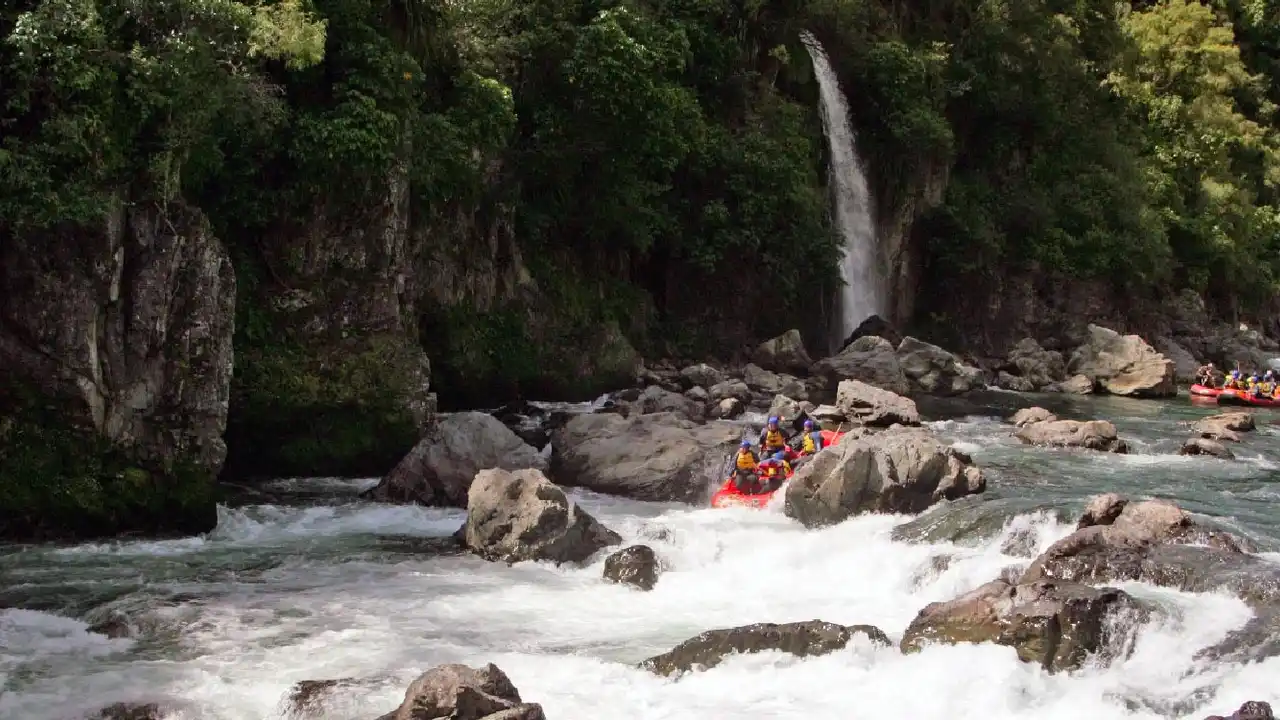
North Island White Water Rafting The Mighty Tongariro River
Okay, so you're itching for some serious white water action in New Zealand? Awesome choice! The North Island’s Tongariro River is calling your name. This isn't just any river; it's a Grade 3 beast, meaning it's got some decent rapids that'll get your heart pumping. Think exhilarating drops, swirling currents, and stunning scenery all around. Perfect for intermediate rafters looking for a solid challenge. You’ll be navigating through crystal-clear waters surrounded by native bush – it's a feast for the eyes and a workout for the arms!Why the Tongariro? It’s easily accessible, offers consistent rapids throughout the year, and has a good range of tour operators who know the river inside and out. Plus, it's steeped in Maori history, adding a cultural layer to your adventure.
What to Expect: Expect a half-day or full-day trip, depending on the operator. You'll get a safety briefing, all the necessary gear (wetsuit, helmet, life jacket), and an experienced guide who'll steer you through the rapids. Be prepared to paddle hard, get wet, and have a blast!
Gear Recommendation: A good waterproof camera case is a must. You'll want to capture those epic moments without destroying your phone. Also, consider bringing a lightweight, quick-drying towel for after the rafting.
South Island White Water Rafting The Untamed Landsborough River
Now, if you're craving something a little wilder, a little more remote, then the South Island's Landsborough River is where it's at. This is Grade 4/5 territory, folks – not for the faint of heart! We're talking serious rapids, challenging maneuvers, and some of the most breathtaking scenery you'll ever witness. Imagine plunging through narrow gorges, surrounded by towering mountains and ancient rainforest. This is an adventure of a lifetime.Why the Landsborough? It’s raw, untamed, and utterly spectacular. It’s also a multi-day expedition, meaning you'll be camping out under the stars, surrounded by the sounds of nature. This is a true wilderness experience.
What to Expect: Expect a 3-5 day trip, depending on the operator. You’ll need to be in good physical condition, as this is a demanding adventure. You'll be provided with all the necessary gear, including rafts, tents, and food. But be prepared to carry your own gear and pitch in with camp chores.
Gear Recommendation: Sturdy hiking boots are essential for navigating the terrain. A good quality sleeping bag is also a must, as nights can get cold. And don’t forget a waterproof backpack to keep your belongings dry.
Tongariro vs Landsborough A Detailed Comparison for Your Rafting Trip
So, North Island vs. South Island? Grade 3 vs. Grade 4/5? Day trip vs. Multi-day expedition? Let's break it down:
- Difficulty: Tongariro is ideal for intermediate rafters. Landsborough is for experienced rafters only.
- Duration: Tongariro is a day trip. Landsborough is a multi-day expedition.
- Scenery: Both offer stunning scenery, but Landsborough is more remote and wild.
- Accessibility: Tongariro is easily accessible. Landsborough is more remote and requires a helicopter flight to reach.
- Cost: Tongariro is more affordable. Landsborough is significantly more expensive.
White Water Rafting Gear Recommendations and Price Comparisons
Alright, let's talk gear. Here are a few specific recommendations to enhance your white water rafting experience, along with price ranges:
- GoPro HERO11 Black: A must-have for capturing your adventure. Waterproof, rugged, and delivers stunning video quality. Price: $399 - $499
- NRS Rafting Gloves: Protect your hands from blisters and provide a better grip on the paddle. Price: $25 - $40
- Astral Loyak Kayak Shoes: Lightweight, quick-drying shoes with excellent traction. Perfect for wearing in the raft. Price: $90 - $120
- Dry Bag (5L - 10L): Essential for keeping your valuables (phone, wallet, camera) dry. Price: $15 - $30
- Sunscreen (SPF 50+): Protect your skin from the harsh New Zealand sun. Reapply frequently. Price: $10 - $20
Choosing the Right Rafting Operator in New Zealand for Your Needs
Finding the right operator is crucial for a safe and enjoyable experience. Here are a few reputable companies that offer white water rafting trips in both the North and South Islands:
- Rotorua Rafting (North Island): Specializes in rafting the Kaituna River, known for its 7-meter waterfall drop.
- Tongariro River Rafting (North Island): Offers a range of rafting trips on the Tongariro River, from beginner to advanced.
- Ultimate Descents (South Island): Operates on the Landsborough River, providing unforgettable multi-day expeditions.
- Queenstown Rafting (South Island): Offers rafting trips on the Shotover and Kawarau Rivers, known for their thrilling rapids.
White Water Rafting Safety Tips Essential Knowledge Before You Go
Safety is paramount when white water rafting. Here are a few essential tips to keep in mind:
- Listen to your guide: They are the experts and know the river well.
- Wear all the provided safety gear: Helmet, life jacket, and wetsuit are essential for your protection.
- Know how to swim: While you'll be wearing a life jacket, it's important to know how to swim in case you fall out of the raft.
- Communicate with your team: Paddle together and follow your guide's instructions.
- Stay hydrated: Drink plenty of water before, during, and after your rafting trip.
White Water Rafting Season and Best Time to Visit New Zealand
The white water rafting season in New Zealand typically runs from October to April. The best time to visit depends on the river and your preferences. Generally, the water levels are higher in the spring (October-November) due to snowmelt, which can make for more exciting rapids. Summer (December-February) offers warmer weather and more consistent water levels. Autumn (March-April) is a great time to visit for fewer crowds and stunning fall foliage.